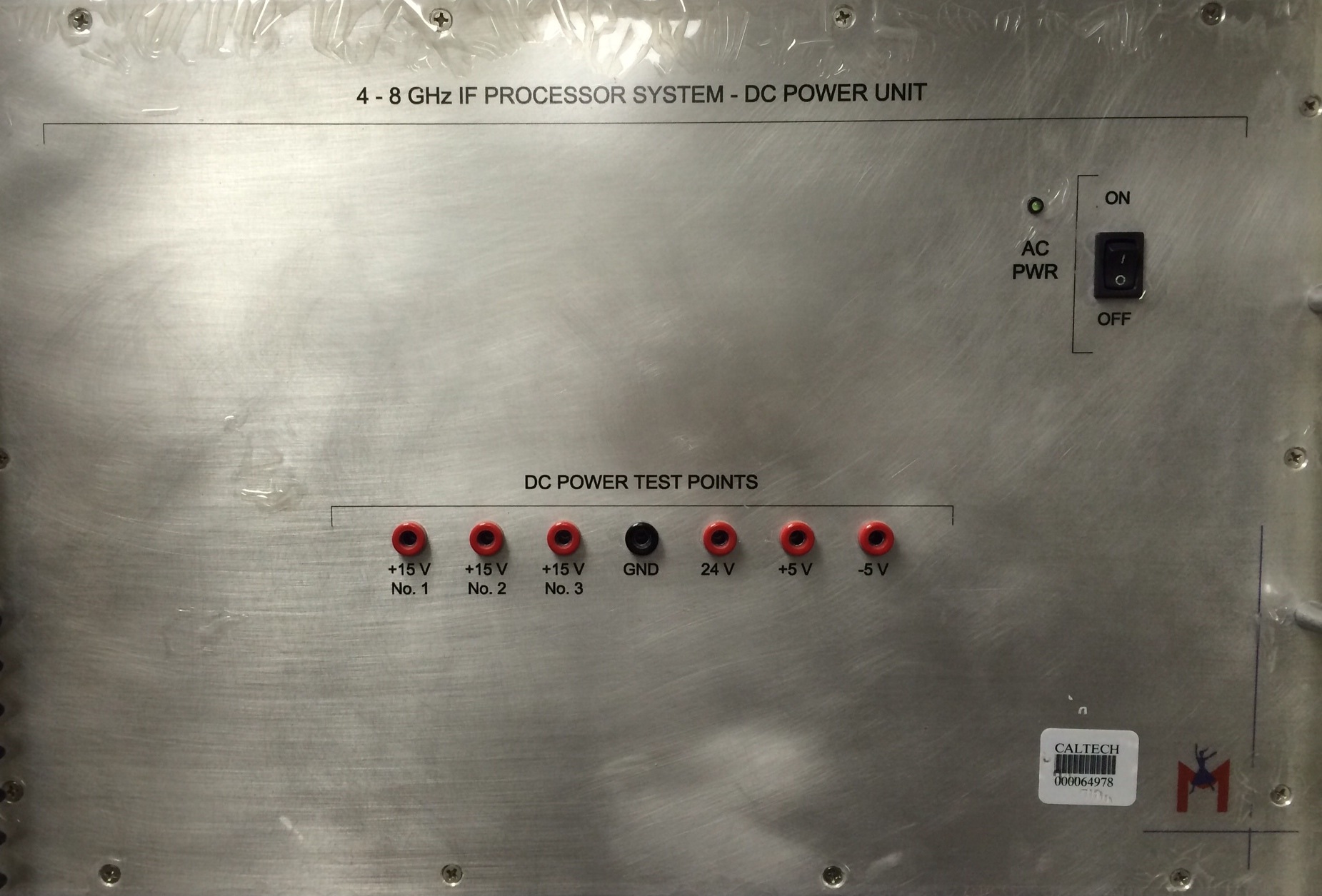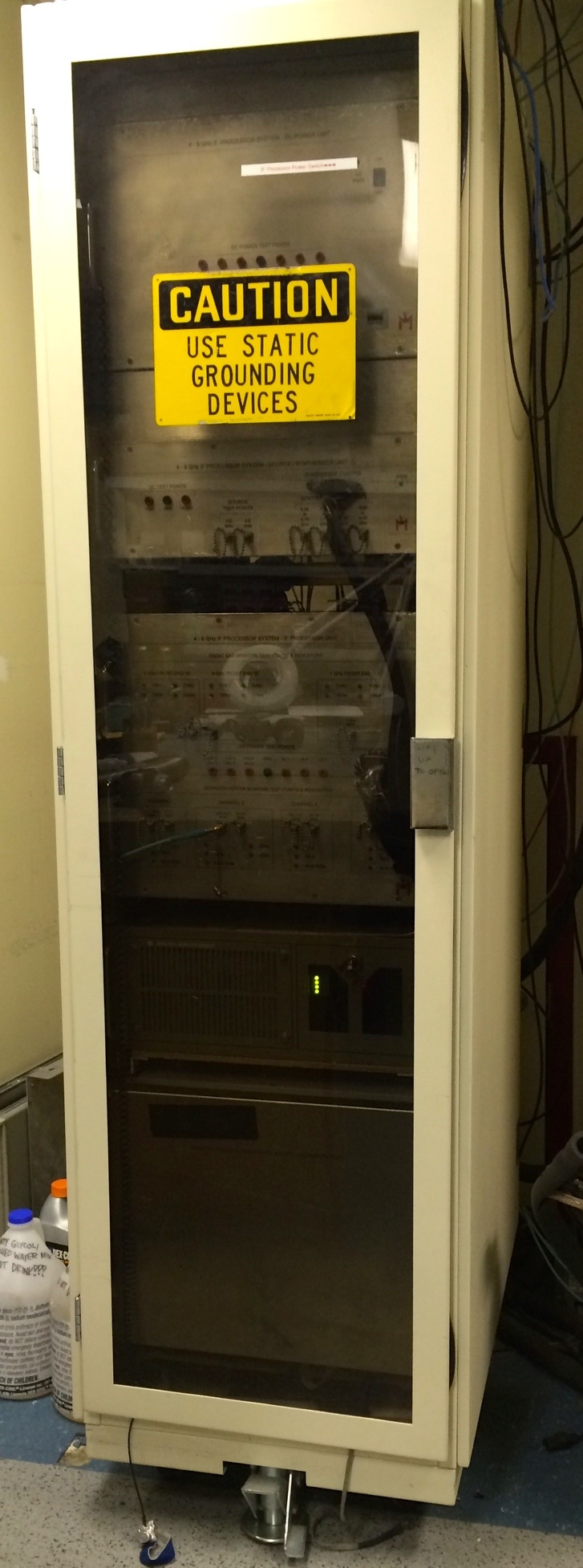Table of Contents
Array Acousto Optic Spectrometer (AOS5)
Developed for the CSO by the University of Köln, the Array Acousto Optic Spectrometer (AOS5) is available with the 345 GHz and 650 GHz narrow band sidecab receivers, the wide band 345 GHz receiver (Barney), and the 850 GHz receiver. It is used with an IF processor developed at the CSO.
The AOS5 is an array of four individual AOS sections. Each section, 1 GHz wide and centered at 2.1 GHz, has a 2048 channel CCD, of which about 1600 channels are illuminated.
| AOS5 Specifications | |
|---|---|
| Sub band width | 4 x 1000 MHz |
| Channels | 4 x 1600 |
| Channel spacing | 650 kHz (0.85 km s-1 at 230 GHz) |
| Effective resolution | 1000 kHz (1.3 km s-1 at 230 GHz) |
The TELESCOPE identifiers in the CLASS headers for the four sections are CSO AOS5 IF1, CSO AOS5 IF2, CSO AOS5 IF3, and CSO AOS5 IF.
UIP commands
UIP> SPECTROMETER /AOS5 /RESTART
will start AOS5. The /RESTART option initializes the synthesizers and the attenuators in the IF processor.
This option must be used the first time the AOS5 is selected and subsequently whenever a different receiver is selected.
If one of the wideband receivers is in use, all four AOS sections are active and displayed in the AOS5 window. If a narrowband receivers is in use, only the AOS section 3 is active.
The sub band center frequencies, usually 4.5, 5.5, 6.5 and 7.5 GHz with the wide band receivers, may be shifted to provide overlap. For example,
UIP> SPECTROMETER /AOS5 0.1 0.033 -0.033 -0.1
will place the center frequencies at 4.6, 5.533, 6.466, and 7.4 GHz. Then the IF coverage will be 4.1-7.9 GHz and there will be 66 MHz overlap between each section.
IF Processor
The IF processor has two input ports for wideband (4-8 GHz IF ) receivers and one input port for narrowband (1-2 GHz IF) receivers. It includes an IF matrix switch to select the input port, dark frame switches and 100 MHz comb signals for each input, and power amplifiers and attenuators for each of four output ports.
With the wideband Cassegrain receiver, Barney, the 4-8 GHz IF band is split into four 1 GHz wide sub bands, centered at 4.5±0.1, 5.5±0.1, 6.5±0.1 and 7.5±0.1 GHz. These sub bands are then down converted and fed to the individual AOS sections.
With one of the narrowband receivers, either the 345 GHz and 650 GHz sidecab receivers or the 850 GHz receiver, the 1-2 GHz IF band is up converted to 6-7 GHz by the IF processor and fed to AOS section 3. This signal is also sent to FFTS1.
Power Supply
To use the AOS5 or to use the FFTS1 with the narrow band receivers, the IF processor must be turned on. The switch is near the top right of the AOS5 rack in the laboratory.
The power supply voltages may be verified through test points on the front panel. If any of these voltages is significantly lower than its nominal value, the power supply must be restarted. If the problem persists, shut down the system and contact the CSO staff. Please turn off the power supply at the end of observing.
Computer
The synthesizers, attenuators, and RF switches in the IF processor are controlled by a computer (rtlinux) colocated in the AOS5 rack. This computer also controls the AOS5 and chopping secondary mirror. Please leave this computer running all the time.
Optionally, the IF processor status may be monitored from the control computer (kilauea) with a program called ifpmon:
kilauea% ifpmon
Quirks
- The AOS5 inputs may saturate if a very strong signal is present. This causes the automatic attenuator adjustment to fail. To workaround, manually set the attenuators to their maximum value (63 dB) prior using the
ADJUST_ATTNcommand or any other commands, such asCALIBRATE, adjust the attenuators automatically. For example:
UIP> DB 63
UIP> ADJUST_ATTN
- When the power level difference between the hot load and the sky is more than 3 dB (i. e., when the Y factor on the sky is greater than 2), manually adjust the attenuators on the sky, add an extra 1 dB (Y factor of 2.7 ⇔ 4.3 dB), then take a
TCALscan:UIP> ADJUST_ATTN
UIP> DB /AOS5 /ADD 1
UIP> CALIBRATE /NOATTENUATOR - The attenuation for each sub band can be set individually with the UIP
ATT1,ATT2,ATT3, andATT4macros. When a strong spur is present within a certain sub band, a majority of CCD pixels in that sub band can grossly be under-illuminated after the ADJUST_ATTN command. The attenuation of the affected subband can manually be reduced at the expense of some additional unusable channels near the spur (due to saturation of CCD pixels). The following procedure is an example of how to set the attenuators when there is a spur in the fourth subband:UIP> RETICON
UIP> ADJUST_ATTN
UIP> ATT4 10
UIP> DB /AOS5 /ADD 1
UIP> NO_RETICON - The logical CCD readout rate of the AOS5 is slower than other spectrometers. Consequently, there is a short delay of 1-2 seconds when each
CHOP_SLEWYcycle is started. For the same reason, the choice of OTF integration time (determined by cell size and scan speed) is more restrictive for the AOS5.

